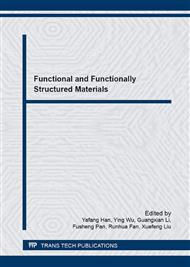p.498
p.505
p.519
p.527
p.532
p.538
p.543
p.551
p.557
Effect of Sintering Temperature on Porous Structures and Mechanical Properties of Ti-39Nb-6Zr Alloys
Abstract:
Titanium and its alloys have been widely used as implants replacing hard human tissues in biomedical fields. To improve the stability of implants in the surrounding bone tissues, the materials with porous structures were fabricated. In this paper powder metallurgy technique was employed to fabricate porous Ti-39Zr-6Nb (wt.%) alloys. The porous structures and mechanical properties of the porous alloys were examined by scanning electron microscopy (SEM) and compressive tests. The results showed that with increasing the sintering temperature the porosity of the alloys decreased and the compressive strength and the elastic modulus increased. The porosity of the alloys was in the range from 20.8% to 23.2%, and the pore sizes mostly centered in 10~30μm. The compressive strength and the elastic modulus were in the range from 110.4 to 292.4MPa and 4.7 to 12.4GPa respectively, which was close to human bone.
Info:
Periodical:
Pages:
532-537
Citation:
Online since:
March 2016
Authors:
Price:
Сopyright:
© 2016 Trans Tech Publications Ltd. All Rights Reserved
Share:
Citation:


